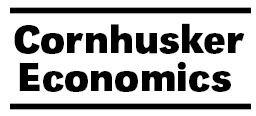Agricultural Economics, Department of

Cornhusker Economics
Date of this Version
3-4-2020
Document Type
Newsletter Issue
Citation
2020 Authors
Abstract
Improving our understanding of the influence of risk- preferences on decision making represents an important objective for understanding behavior, designing policy and decision making theory. A natural place this problem persists is in the marketing of grain (Kastens and Dhuyvetter, 1999). Grain marketing research has primarily focused on the use of different marketing techniques that result in lower price risk and, therefore, lower-income risk (Musser, Patrick, Eckman, 1996). However, the extent to which the theoretical findings from these studies are relevant to real-world applications is not clear (Brorsen and Irwin, 1996; Garcia and Leuthold, 2004). While reducing income risk is desired, this approach overlooks the influence of producer risk preferences when marketing grain. In this article we evaluate the role of producer risk preferences, specifically Safety-First (SF)risk preferences (Roy 1952) on grain marketing decision behavior with emphasis on post-harvest grain marketing.
The idea behind SF is that individuals consider outcomes below a particular value as a disaster. Each individual would have his/her own disaster level. For farmers, a disaster could mean losing the farm or losing money in a particular crop year. Producers exhibiting SF risk preferences will make on-farm decisions in a way to minimize the probability of achieving the disaster. For example, Fishburn (1997) found decision-makers do associate risk with failure to meet a target return. Heady (1952) presented that farmers exhibit SF preferences by allocating acres to particular crops in an attempt to minimize the probability of income falling below a disaster level defined as production costs. Given this context, we used a grain marketing simulation game to conduct a context-rich economic experiment with university student subjects to evaluate the role of SF risk preferences on grain marketing decision behavior.
For our economic experiment and given our focus on SF risk preferences, we relied on the work by Levy and Levy (2009) to identify whether experimental subjects exhibit SF risk preferences. This information is then combined with post-harvest grain marketing decisions made during the experiment within the simulated grain marketing interphases where subjects create contracts for spot or future grain delivery under four different grain price scenarios.


Comments
agecon.unl.edu/cornhuskereconomics